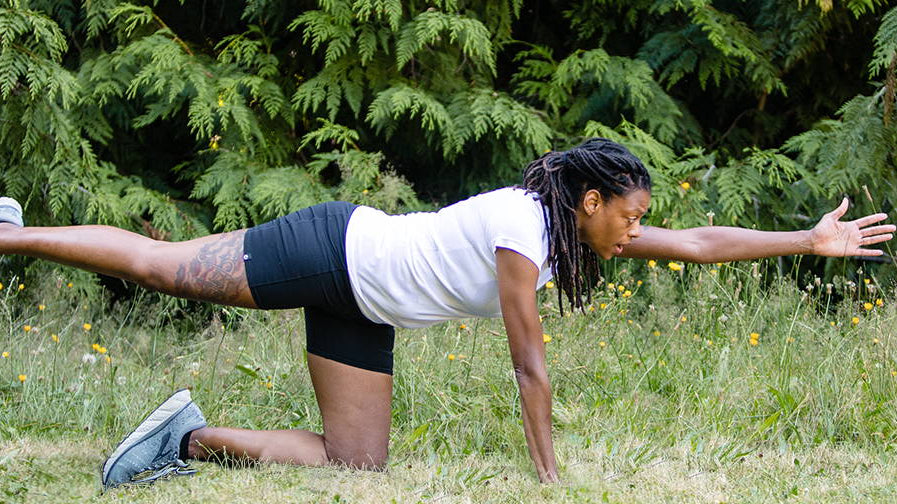BY: JASMINE BLOCKER
Hey everyone! So I’m always asked how exactly a long sprinter trains. Do I just run 400 meters over and over again? My answer is no, it’s a bit more complicated than that.
The 400m dash is interesting because it requires a high level of speed over a (rather ridiculously) long period of time. While no one has ever claimed the 400m to be an easy event, science and proper training can always help you get you physically prepared.
In a nutshell, my coach dedicates Monday to speed endurance, Tuesday to lactic acid tolerance, Wednesday to active recovery and general fitness, Thursday to speed work, explosiveness, and block work, and Friday to intensive tempo work. On top of this, I do Olympic and accessory weight lifting on Mondays, Wednesdays and Fridays. Building strength in the weight room increases the amount of force I apply to the ground, which in turn propels me down the track faster.

Monday - Speed endurance
My coach likes to kick the week off with speed endurance. These workouts are tough, so they make me at least somewhat nauseous (if I’m doing them right). Performing 150m-200m reps near race energy effort or faster improves strength under fatigue. Not to mention that developing basic speed enables you to run the race with significantly less effort. After the workout, I usually continue with plyometric jumping activities (e.g. hurdle hops, alternating bounds, tuck jumps) to develop explosiveness.
Example:
- Workout: 5 x 150m
- Plyometric jumping: 3 x 6 hurdle hops, 2 x 20 tuck jumps, alternating bounds
- Weights: total body lift (focusing on lower body)

Tuesday - Lactic acid tolerance
Tuesday workouts separate the girls from the women. On these days we focus on lactic acid tolerance, making this the hardest day of the week by far. By producing more lactate in training we try to simulate the final 100m of a race. This excruciating final stretch of the race is why the 400m dash gets such a bad rap.
Quarter-milers often experience pain likened to “dying,”“hitting a wall,” or (my personal favorite) “a monkey jumping on their back.” What causes this? The 400m dash requires contributions from the anaerobic glycolytic system, which produces large amounts of metabolic waste products (e.g. lactate) that ultimately leads to the “burning” feeling in your legs and reduced ability to produce more energy as the race continues.
So, it’s not surprising that 400m races are won and lost in the last 100m, usually by the athlete who “dies” the least (i.e. decelerates the least). Nobody wants to get walked down only a few meters from the finish line! Pushing my body to produce lactate in workouts trains my system to use and remove these products so I can run faster for longer on race day.
Example
- Workout: 4 x 300m with a strong 200m finish

Wednesday - Active recovery day
After a Tuesday workout my body is crying out for some TLC. Thankfully, my coach agrees! Wednesday workouts are dedicated to accelerating recovery and general fitness.
While its the perfect time to indulge in recovery treatments like a soft tissue massage, my coach also has me take out some time to cross-train. I usually pick a spin class or hot yoga class (anything to get a good sweat going) at a local studio. Later in the day, I’ll do a bodyweight circuit that focuses on strengthening smaller muscles (e.g. ankles, abs, lower back, hips) that might get a bit neglected during my usual Olympic lifting sessions.
Example
- Workout: Spin class
- Treatment: 10 minute ice bath, 20 minutes in recovery boots, soft tissue massage
- Weights: Total body lift (focusing on upper body)
Thursday - Speed work, explosiveness, and block work
Thursday is the day of the week I look forward to most! These workouts are a little different, and a lot more fun. Thursday is dedicated to speed and explosiveness and tends to be more technical. My coach often puts me through a combination of speed drills, sled pulls, block starts, and wicket drills, focusing on running form and the initial phase of the race.
Even though it’s fun to add more “toys” to the mix, you’ve got to stay focused. A Thursday workout proves over and over again how running is far more complicated than simply putting one foot in front of the other. For example, improving my hip position as I get out of the blocks prepares me to get off the line and accelerate quickly on race day.
Example
- Workout: 5 x 30m wickets, 3 x 40m sled pulls, 5 x 60m

Friday - Intensive tempo work
If you’ve ever seen sprinters train, you’ll notice that each rep is usually followed by ample rest. Fridays are the exception to that rule.
On these days we slow down the pace of each rep and the rest is pretty much nonexistent (super fun right?). Stepping back on the line before I’ve had a chance to catch my breath isn’t really my jam, but these workouts are crucial to recover from hard training and improve general fitness.
Example
- Workout: 3 x 3 x 200m with 30 seconds rest
- Total body lift (focusing on lower body)










